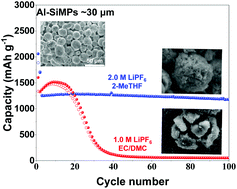Low-cost batteries based on industrial waste Al–Si microparticles and LiFePO4 for stationary energy storage†
Abstract
Owing to their high capacity and low working potential, Si-based anodes are regarded as potential alternatives to graphite anodes to meet the higher requirements of Li-ion batteries (LIBs). However, high volume change causes the fracturing and pulverization of the bulk anode and continuous side reactions, which are more severe in large-particle Si anodes, limiting its practical application. Herein, to build a low-cost battery system, we chose a common industrial waste product, Al–Si microparticles (Al–SiMPs, ∼30 μm), as the anode for LIBs and coupled it with a 2.0 M LiFP6 2-MeTHF electrolyte to support its operation. The Al–SiMP anode showed a high specific capacity and a significantly improved electronic conductivity, ensuring high energy and power densities. An ultra-high initial coulombic efficiency (iCE) of 91.6% and a cycling CE of ∼99.9% were obtained in the half-cells, which delivered a capacity of 1300 mA h g−1 and maintained 95.3% after 100 cycles. Paired with low-cost and high-safety LiFePO4 as the cathode, the LFP||Al–SiMP full cells showed decent cycling stability and exhibited a considerable cost advantage, demonstrating a competitive solution for stationary energy storage.



 Please wait while we load your content...
Please wait while we load your content...